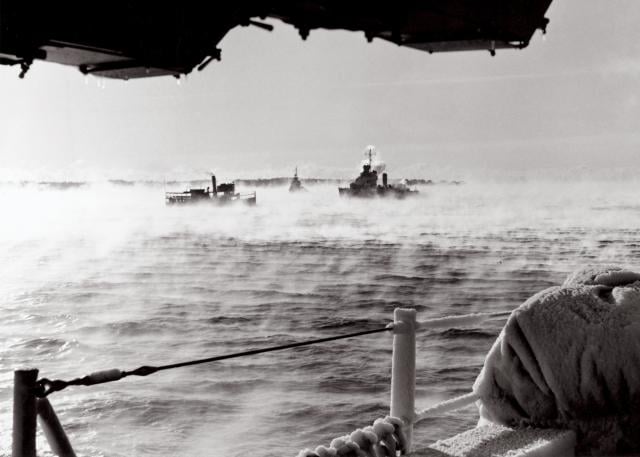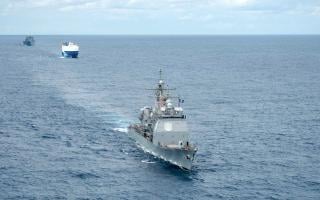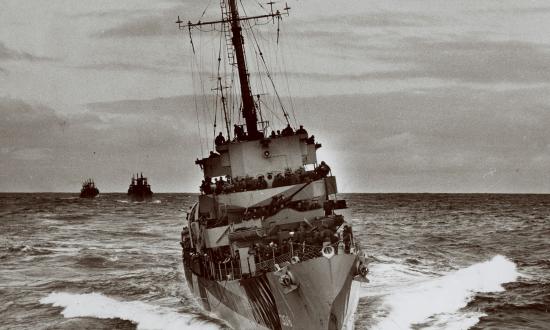“If a service does not possess a well-defined strategic concept, the public and the political leaders will be confused as to the role of the service, uncertain as to the necessity of its existence, and apathetic or hostile to the claims made by the service upon the resources of society.”1
Samuel Huntington wrote these timeless words in Proceedings nearly 70 years ago, not even a decade after the end of World War II and the peak of U.S. maritime power. Huntington contended the Navy, at the time, was too focused on fighting other navies at sea—too “Mahanite,” he termed it. Instead, he argued, the Navy’s “purpose now is not to acquire command of the sea but rather to utilize its command of the sea to achieve supremacy on the land.” Carrier aviation, amphibious power, and naval artillery would be the Navy’s means to strategic impact. Since the 1950s, except for a brief interlude, the Navy roughly has followed this advice.
Unfortunately, the Navy’s focus on projecting power ashore has led it astray because of both an incomplete reading of history and decades of great power peace that left ideas unchallenged by peer conflict. The Navy needs a new strategic concept for the 21st century. To tell the nation a compelling story about the purpose of its Navy, the service must return to its roots: sea control. Doing so, however, requires returning to the defining event in the history of the Navy: World War II.
A War Won, But How?
If there is any lesson to be learned from World War II, it is that individual battles are rarely decisive. Instead, what matters is a nation’s ability to degrade and destroy the systems an adversary uses to generate, deploy, and sustain its armed forces. These “superbattlefields,” as historian Phillips O’Brien terms them, stretch thousands of miles and include the raw materials, factories, training grounds, and other systems that feed into the battlefield.2 Within this framework, navies are essential.
Viewed through this lens, the Navy’s contributions to victory in World War II become clear. In the Pacific, the Navy–Marine Corps team not only defended Allied supply lines, but also fought to interdict Japan’s ability to do the same.3 Securing forward bases through the “island-hopping strategy” was fundamentally about cutting off Japanese forces while simultaneously better positioning Allied forces to attack Japan and Japanese lines of communication. Because of the limited range of land-based aircraft, aircraft carriers provided critical air cover and strike capability to the leapfrogging amphibious forces. Once forward bases were secured, land-based aircraft could take over and free the carrier forces for other offensive actions.4 Simultaneously, submarines continually attacked Japan’s war-making capability.
In the Atlantic, there was no need to secure forward island bases for the assault on occupied Europe. Land-based aircraft could already cover an invasion force, so the Navy’s offensive contribution would be limited to providing escorts, transports, and gunfire support to invading forces.5 But, while it was land-based airpower that crushed the German Luftwaffe and crippled the Wehrmacht’s mobility, these victories would not have been possible without the logistics train defended by the U.S. Navy. Most of the men, materiél, and supplies used by the mighty Allied air forces first had to cross the Atlantic. Winston Churchill perhaps best explained its importance, writing, “The Battle of the Atlantic was the dominating factor all through the war. Never for one moment could we forget that everything happening elsewhere, on land, at sea or in the air depended ultimately on its outcome.”6 Sea control alone could never win the war, but its absence could have lost it.
Taken in summary, the Navy’s contribution to victory depended on circumstance. When the military situation required it, such as in the Pacific, the Navy built huge offensive forces to secure bases and carry the fight to the enemy. When geography and the military situation allowed other services to better deliver combat power, such as in Europe, the Navy played more of a supporting role. But, regardless of whether the Navy was the primary or supporting service, all action depended on secure sea lines of communication.
A Cold War Navy
Throughout the Cold War, the Navy focused on maintaining the great carrier forces that had brought it glory and victory during World War II. Most of the smaller combatants—those that had been so vital to defending sea lines of communication—were mothballed, sold, or scrapped. In the face of declining defense budgets, the Navy would fight to maintain its core offensive firepower.
The exigencies of the Cold War also supported the Navy’s choices. The wars in Korea and Vietnam, not to mention other potential conflict areas, highlighted the utility of a Navy capable of operating in international waters and projecting power ashore. More broadly, the Soviet Union’s status as a continental power drove analysts such as Huntington to argue the Navy’s purpose was using the sea to influence events on land.
For the majority of the Cold War, the Navy focused on projecting power ashore. The notable exception was during Admiral Elmo Zumwalt’s tenure as Chief of Naval Operations (CNO) from 1970 to 1974. Zumwalt analyzed the problems facing U.S. forces, namely, the block obsolescence of World War II platforms and an ascendant Soviet Navy, as part of Project 60. Developing a new set of priorities, Zumwalt placed the control of sea lanes second only to assured nuclear second-strike capability. He wrote, “Heavy reliance on sealift is an integral part of the U.S. role as a sea power. It emphasizes the absolute need to be able to control the seas if the nation is to exist.”7 While a notable change from the status quo, the emphasis on sea control was to be short lived.
Instead, a series of carrier admirals reoriented the Navy back toward power projection and using the Navy as a core component of an offensive victory. The 1986 Maritime Strategy was the ultimate manifestation of this desire. The “600-ship Navy,” a powerful goal for budget battles, would allow the Navy to carry the fight to the Soviet Union and favorably influence peacetime competition, the war itself, and conflict termination.8
The end of the Cold War only reinforced the Navy’s proclivity toward fighting ashore. Decades of operations in the Middle East benefited from a Navy geared toward strike operations from the sea and supporting forces on land. But, as the Navy has worn out its ships and aircraft supporting wars in the desert, Chinese military power has slowly, then quickly, grown.
The Challenge
The United States defends—and benefits from—a global system. The frontline of this global system rests in the first island chain with U.S. allies and partners such as Japan, Taiwan, and the Philippines. They face an ascendant China at their front door. Nowhere has this ascendancy been more evident than in the growth of the People’s Liberation Army Navy (PLAN). Over the past several years, the PLAN has surpassed the U.S. Navy in numerical strength, especially in local waters. Simultaneously, Chinese air, space, and rocket forces are able to contest U.S. military dominance to a degree not seen since World War II.8
The U.S. Navy has simultaneously faced numerous challenges. It has struggled to gain the funding necessary for modernization and capacity improvements. It is, as during Zumwalt’s time, facing the block obsolescence of ships such as the Ticonderoga-class guided-missile cruisers and Ohio-class guided- and ballistic-missile submarines. It has developed multiple force designs and strategies over the past decades, none of which has manifested itself or proved enduring. The Navy continually struggles to explain its purpose. As then-Congresswoman Elaine Luria stated in an interview, “I just cannot beat the drum enough that we need to continue to grow the fleet. . . . The truth is, we really need to frame the reasons behind why we need this fleet.”10 Without a coherent strategic concept, it is unclear how additional dollars will translate into greater national security.
This is problematic not just for the Navy, but also for U.S. warfighting capability writ large. Just as the Navy was the essential service during World War II, so it would be again in any notional conflict with China. The United States must to project power over thousands of miles to defend its forward allies, and the only way to do that sustainably and at scale is by sea. As China looks to contest the United States’ ability to use the sea to its advantage, it falls to the Navy to fight back. The Air Force can deliver fires, the Army can hold land, but only the Navy can continually contest the sea and use it to the nation’s benefit. The Navy must articulate its core mission as sea control.
A Path Forward
The first step to articulating a new strategic concept is recognizing the Navy’s role during wartime. While any notional conflict with China likely would take place in the Pacific, the Pacific theater of operations during World War II is a poor mental model for a modern conflict. There are two fundamental differences. Then, the United States was on the strategic offensive; today, it would be on the strategic defensive. Second, Japan made a critical error in not interdicting Allied sea lines of communication. While it is possible China could make the same mistake, its force structure and writings indicate its intent to interdict allied logistics trains.11 In any conflict with China, the United States would rely on its Navy to ensure the forward resupply of its forces and its allies.
Thus, it is more likely that, in a future conflict with China, instead of refighting World War II in Pacific, the Navy will have to refight World War II in the Atlantic. The similarities are striking. The United States would be attempting to simultaneously defend and resupply forward forces while suppressing Chinese fires. This roughly mirrors the European campaign. Instead of traversing the Atlantic, the United States would be traversing the Pacific. Instead of fighting U-boats, the United States would be fighting a variety of Chinese forces. Instead of resupplying Britain, the United States would be resupplying Taiwan and other allies. Instead of the Army Air Corps fighting the Luftwaffe, it would be joint air, sea, and space power attempting to defend Taiwan and disrupt Chinese activity. Critical to the whole operation would be the Navy’s ability to ensure the forward deployment and sustainment of forces. It is unlikely a single battle would be decisive; instead, it would be a defensive fight dominated by attrition.
Ensuring sea control, defending a logistics train, and fighting a maritime war is a mission that should be appealing to the Navy. It requires many capable warships, benefits from naval airpower and aircraft carriers, and is a uniquely naval mission. It is puzzling the Navy is not arguing more forcefully for such a role. Naval leaders need to tell Congress and the American people a story that highlights the indispensable utility of the Navy during wartime.
A Story for a 21st-Century Navy
Instead of platitudes about “presence,” “deterrence,” and “global commons,” the Navy should firmly anchor its purpose in sea control.12 Naval leaders should communicate that the mission of the Navy—in peace and war—is to ensure the United States can use the seas for its own purposes and deny the sea’s use to its enemies. The Navy may have a power projection role on its own, but its purpose is to ensure the United States and its allies can project power. To do this, it must control the seas.
The joint force and U.S. allies will rely on the U.S. Navy to ensure the forward generation of meaningful combat power. This includes the Air Force, whose bombers will struggle to get in the air without fuel and need large quantities of weapons to remain lethal. It will include the Army and Marine Corps, who cannot get to the fight or sustain themselves without Navy logistics support. And it includes the striking arm of the Navy—its missile and torpedo launchers—whose punch is more limited if they must transit long distances to rearm and resupply. U.S. allies likewise will depend on the Navy to ensure the sustainment of their militaries and civilian sectors.
Practically speaking, this mission manifests itself in the Navy escorting shipping from all over the world to forward locations in the first and second island chains.13 It is a mission with many challenges. The proliferation of antiship missiles of all kinds and persistent surveillance technology make the “convoy” escort mission more challenging than ever. It is possible the solution may lie in a different construct. But, just as the Navy rose to the challenge in previous conflicts, it can do so again today. With a clear mission and a clear purpose, the Navy can focus on procurement and experimentation for success during wartime.
The Navy is a vital and indispensable part of the U.S. armed forces, and it requires large peacetime expenditures to ensure capability in wartime. Increased expenditures mean increased scrutiny to ensure those dollars are spent wisely. As Huntington said, a service without a coherent strategic concept will struggle to find support for its cause. But the opposite also is true. A Navy that can clearly explain its purpose and its mission will find support across U.S. society. With that support will come the dollars and personnel necessary to prevail in peace and war.
1. Samuel P. Huntington, “National Policy and the Transoceanic Navy,” U.S. Naval Institute Proceedings 80, no. 5 (May 1954).
2. Phillips Payson O’Brien, How the War Was Won: Air-Sea Power and Allied Victory in World War II (Cambridge, UK: Cambridge University Press, 2015).
3. O’Brien, How the War Was Won.
4. But these land-based aircraft still depended on sea lines of communication. For one notable example, while the Army Air Forces dropped the atomic bomb on Japan, the Navy had to first deliver the atomic bomb to the Army Air Forces.
5. Carrier-based aviation did participate in a few operations (Torch, Dragoon, etc.), but its contributions were relatively minor compared to the total weight of Allied airpower. Torch was likely where it had the greatest contribution because of the dearth of land-based airpower (the USS Ranger and four escort carriers provided air support).
6. Winston S. Churchill, The Second World War: Closing the Ring (Boston, MA: Houghton Mifflin, 1951), 6.
7. ADM Elmo Zumwalt, USN, “Project SIXTY,” memorandum, 16 September 1970, in U.S. Naval Strategy in the 1970s: Selected Documents, John B. Hattendorf, ed. (Newport, RI: Naval War College Press, 2007).
8. ADM James D. Watkins, USN, “The Maritime Strategy,” U.S. Naval Institute Proceedings 112, no. 1 (January 1986). While the Maritime Strategy was ostensibly developed to threaten Soviet ballistic-missile submarines in their bastions, it is not clear why doing this would require carrier groups fighting in the Arctic.
9. Congressional Research Service, China Naval Modernization: Implications for U.S. Navy Capabilities—Background and Issues for Congress (Washington, DC: Congressional Research Service, 15 May 2023).
10. Diana Stancy Correll, “Navy Needs Clear Maritime Strategy to Expand Fleet: Navy Vet Lawmaker,” Navy Times, 10 February 2022.
11. Christopher Woody, “In a War with China, the U.S. Navy’s Warships Might Not Be the First Target,” Business Insider, 5 January 2020.
12. ADM Michael M. Gilday, USN, Navigation Plan 2022 (Washington, DC: Department of the Navy, June 2022).
13. David Alman, “Convoy Escort: The Navy’s Forgotten (Purpose) Mission,” War on the Rocks, 30 December 2020.









